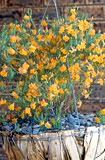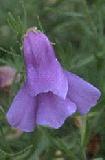|
[Front Page] [Features] [Departments] [Society Home] [Subscribe]

A Mid-winter's Patch
Hans Griesser
We've had days with cold winds and showers, and even some good drenching rains, but nevertheless I have been able to do some gardening almost every weekend. Winter gardening includes chores such as the pruning of the various orchard trees, which needed a good prune this year; hopefully this will eliminate the leaf fungus diseases which I am reluctant to spray against. And as every year, the three kiwifruit vines have grown rampant, climb into and over the rest of the garden given half a chance, and need to be cut back hard. Then there's other yard duties such as chopping and ferrying firewood, cleaning out the hen house, cutting up an unidentified Acacia that had died last summer, etc.
But there's time left to wander and admire, and to plant more. It's been a good first half of winter, with lots of Banksia and Hakea flowers, complemented by various others. I had deliberately set out years ago to have flowers in seasons other than spring, and it's paying off and keeps the birds humming.
Conspicuous are the Eastern Spinebills, which flit around in the lower bushes and are best observed on the grevilleas and correas, whereas the wattlebirds favour the tall banksias. Today I spied an Eastern Spinebill on the Eremophila glabra 'Murchison River' - the bright colours of the bird made a wonderful contrast against the silvery foliage and the red flowers.
The banksias - ericifolia, spinulosa, integrifolia, occidentalis, 'Giant Candles', and marginata - are flowering very nicely and have been doing so for weeks. Banksia speciosa still has a few flowerheads but the main flush was in late summer and early autumn. But you know all about those species, so I'd rather tell you a little about some less commonly grown ones.
Banksia seminuda has finished flowering but was a major attraction in late autumn and early winter not just for me, but also for the black cockatoos and the sulphur-crested cockatoos. If you haven't heard of B.seminuda, it's probably because until recently it was a subspecies of B.littoralis, which is also well established in my garden but younger. I grew both from seed; I doubt that plants would be commercially available.
B.seminuda, known as the 'river banksia', grows as a tree in the southwest of Western Australia in moister and richer soils than other banksias. Planted in 1993, it has been the fastest-growing of any plant in my garden (with B.littoralis a close second; it should flower soon too) and has grown into a beautiful tree with fresh green foliage, but its shape was marred a bit when a gale took a fair bit of the upper crown out. The flowerheads, 20 cm and more in height, are beautiful with yellow perianths and red styles, but the lowest was a good 3 m above ground, so I needed binoculars for a close look! But the cockatoos found them easily and feasted on them as well as on the cones from last year's flowering.
Right next to that tree is a mature B.integrifolia which offered them a menu choice! The round underneath these two trees is littered with the leftovers from their meals, and twigs pruned off so they could get at the food more easily.
Among the shrubs, Grevillea magnifica is eye-catching with its long flowering racemes held high above the foliage. With its long, narrowly divided leaves the bush, 2 m tall, is not dense but has a most attractive shape and leaf colour. There are never many flowerheads at once but it flowers for months. The flower colour is a most unusual dark pink, maroon, and bluish green; this is the main difference to the closely related G.petrophiloides whose pink flowers appear in spring and summer. These species, especially the latter, are sometimes considered difficult but both grow on their own roots here. So does G.pimeleoides which has grown rapidly and is full of flowers at present; they are small individually but a bright yellow with red.
 |
 |
Contrasting habits:
Grevillea petrophiloides (left), a spectacular flowering sgrub to about 2-3 metres high.
Lechenaultia formosa. orange form (right), a low growing species to 0.3 metres, which does well in a container.
Select the thumbnail image or highlighted name for a higher resolution image (33k and 39k). Photos: Keith Townsend, Brian Walters
|
Closer to the ground, conspicuous bright patches are provided these weeks by the orange-yellow flowers of Lechenaultia formosa, which I find very easy to grow from cuttings and establish, so it goes into every sunny gap. The red flowered form is less vigorous for me and flowers less prolifically.
Hakea scoparia flowered for the first time this winter, with pinkish-cream flowers which are on old wood but nevertheless easy to see because the long needle leaves are not dense. The pink flowers of Hakea verrucosa are also quite conspicuous; this is a low spreading shrub whereas H.scoparia grows in the shape of a narrow 'broom'.
In contrast, the large yellow flowers of Dryandra longifolia, which merge along the stems, are best spotted from close up. It is a shrub of 1.2 m height and 2 m width, with branches that tend to spread horizontally. The long serrated leaves make it a very attractive plant but hide most of the flowers.
Despite the weather, some eremophilas are producing their first annual flowers - probably vanguards sent out to explore whether winter might be nearing its end. You all know E.maculata and E.glabra with their diversity of colours and habits, and E.nivea is also fairly well known. This is one of my favourite plants with its silvery-grey leaves and the purple flowers, a couple of which attracted my attention today; last year it flowered until December. It strikes easily for me as do a lot of eremophilas.
A beautiful low plant is Eremophila enata with its many rosy pink flowers among darkish green foliage. I bought this as a small tube from the Langs' nursery in Mildura in the spirit of "let's try although there's a risk it might not like the climate". So far it has done very nicely and it flowered for a long time last year. But most of the eremophilas are still waiting for better weather to start flowering.
 |
 |
The contrast of the vivid red flowers and silver foliage of the Murchison River form of Eremophila glabra (left) is spectacular. while the large flowers of Eremophila macdonnellii (right) never fail to attract attention.
Select the thumbnail image or highlighted name for a higher resolution image (25k and 24k).
|
A surprising variety of eremophilas have adapted to the Dandenongs winter climate; I try to help them by ensuring good air circulation and drainage. Some grey mould attack can occur on hairy leaved species and this requires removal of affected branchlets. Fortunately even for the very hairy E.macdonnellii 'Northern Simpson Desert form' the damage is quite limited and just amounts to some pruning - but I inspect them every weekend to catch infections early. For reasons I don't understand such attacks are localized on just a few plants. Some hairy plants such as E.nivea have so far escaped any harm this winter. Is there an interaction with root health?
This hypothesis may be supported by the observation that much less hairy species can show dieback of branchlets without fungal growth on the leaves. Maybe the grey mould just comes along to colonize branchlets that are dying anyway ? A specimen of E.christophori - a magnificent upright species with long columns of purple flowers - has been affected quite badly this winter, with much of the younger leaves and stems turning brown, and two plants of E.racemosa also have lost a fair bit of the upper growth. I speculated that perhaps this might be frost damage but a third specimen of E.racemosa is totally unaffected. By the way, both forms of E.racemosa are easy to grow from cuttings (one form turns from orange to pink as the flowers open, the
other form from yellow to white).
A special pleasure for me is to detect the first flower buds on plants I have grown and nursed for some years. Oh, the anticipation: will they be as showy as I hope? Several banksias are at this stage now: B.praemorsa (both the wine-coloured and the yellow-flowered forms), B.telmatiaea and B.candolleana. B.telmatiaea, a low, compact shrub, is not among the more spectacular western banksias but reportedly is becoming quite rare due to habitat loss. In an effort to assist in conservation by cultivation, I have established two specimens.
Less of a pleasure is the damage blackbirds cause. They fling so much mulch onto low growing plants, and every weekend I spend time removing mulch piled on top of lechenaultias, kennedias, hibbertias, etc, and from around the stems of all other plants (to avoid the danger of stem rot). Occasionally, trapping makes a small dent in the blackbird population, but the problem really only stops for a while when they move on to our currants, strawberries, raspberries, and blueberries! What do readers do to keep mulch more or less in its place? Don't recommend getting a cat - we have one but also a curfew for cats, and moreover our cat is a longhair that has never shown any inclination to hunt and instead sleeps 23 ½ hours a day.
From the newsletter of the Foothills Group of the Australian Plants Society (Victoria), August 2000.

[Front Page] [Features] [Departments] [Society Home] [Subscribe]
Australian Plants online - June 2001
Association of Societies for Growing Australian Plants
|